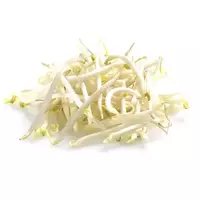Mung bean sprouts

Mung or mash beans (Vigna radiata) are a leguminous crop whose birthplace is considered to be India. Mung beans are called golden beans or Phaseolus aureus. Moong are small beans of an oval, almost rounded swamp-green shape. Mung beans received their original name thanks to the oldest Indo-Aryan Hindi language.
Mung beans have found widespread use in the general Asian national culinary tradition. mung beans are most popular in countries such as China, Japan, India, Korea, Thailand and other countries of Southeast Asia. In addition, mung beans are an integral part of Tajikistan's national cuisine. For example, the famous Tajik vegetarian pilaf shawla-mash or mash-kichiri is made from rice, as well as mung beans.
In India, processed masha or dhal beans are most commonly used, as well as mung bean sprouts. For dhal, mung beans are subjected to additional treatment, during which the green shell is removed. Mung beans turn light green and cook beautifully. Based on dhal, pasta is prepared, as well as kichari or a healing dish of folk Indian medicine ayurveda, as well as desserts. Mung bean sprouts, as well as sprouted beans, soybeans and wheat, are considered an inapplicable ingredient in the Asian culinary tradition.
Mash grows quickly, so mung bean sprouts can be obtained if some conditions are met in a day. Mung bean sprouts have exceptional beneficial qualities. Studies have shown that sprouted mung beans contain a much larger number of useful compounds of natural origin. The thing is that a large number of compounds necessary for the growth and development of the plant are accumulated in the sprouts of mung beans.
Mung bean sprouts are considered a powerful energy resource for the human body. Mung bean sprouts can be eaten fresh as part of salads, as well as soups and main dishes. Mung bean sprouts are great as a fresh and light diet side dish for meat dishes. Mung bean sprouts can be fried in olive oil with soy sauce and spices. Mung beans can be sprouted at home. This will take from 3 to 5 days. Beans are washed and sorted to keep debris out.
Mung beans are soaked in room-temperature water overnight, then washed with water and placed in a jar, which is covered with gauze instead of a lid. Beans are cleaned in a dark place. You should periodically drink the beans with water, for this the jar is turned over and placed in a bowl of water at an angle of 45 degrees. It is believed that the maximum benefit will be brought to the human body by the sprouts of mung beans not exceeding 1 cm in height.
mung bean sprouts 29.81 kCal
Energy value of mung bean sprouts (Ratio of proteins, fats, carbohydrates - ju):
Proteins: 3.08 (~ 12 kCal)
Fats: 0.19 g (~ 2 kCal)
Carbohydrates: 5.96 g (~ 24 kCal)
Energy ratio (b | y): 41% | 6% | 80%
 Español
Español Français
Français Português
Português Русский
Русский 简体中文
简体中文 繁體中文
繁體中文 日本語
日本語 한국어
한국어 العربية
العربية Türkçe
Türkçe Қазақ
Қазақ Deutsch
Deutsch Italiano
Italiano Українська
Українська
